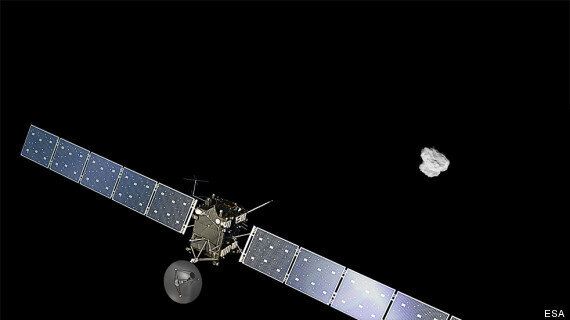A European spacecraft is due to rendezvous with an icy comet tomorrow after an epic 10-year journey across the Solar System.
Launched in March 2004, the Rosetta probe's odyssey has already taken it four billion miles across the asteroid belt and more than five times the Earth's distance from the Sun.
It is now closing in on its quarry, comet 67P/Churyumov-Gerasimenko, a lump of ice and dust swinging in a wide circuit round the Sun at around 34,175 mph.
The spacecraft will match the comet's speed to within walking pace as it "arrives" at a distance of just 62 miles.
In November, Rosetta will deploy a small robotic lander, Philae, which will steer itself to the comet's surface.

Philae will send back images and conduct the first in-situ analysis of a comet's composition.
For the next 17 months, Rosetta will remain close to 67P/Churyumov-Gerasimenko as it heads towards the Sun and heats up, throwing out increasing amounts of gas and dust.
Together, Rosetta and its lander will conduct the most detailed analysis of a comet that has ever been attempted.
Since early May, controllers at the European Space Agency's operations centre in Darmstadt, Germany, have been putting Rosetta through a tightly controlled series of manoeuvres designed to reduce its speed by around 1,740 mph.
Repeated burns of the craft's thrusters were made to slow the craft and position it alongside the comet.
A mistake during this critical period could have jeopardised the entire mission.
"If any glitches in space or on ground had delayed the recent burns, orbital mechanics dictate that we'd only have had a matter of a few days to fix the problem, re-plan the burn and carry it out, otherwise we would have run the risk of missing the comet," said Trevor Morley, a flight dynamics specialist at the ESA Space Operations Centre (ESOC).
More challenges lie ahead as the comet becomes increasingly active and its coma - the halo of gas and dust surrounding its nucleus - grows.

ESA orbital mechanics expert Frank Budnik said: "On top of a good physical model of the comet nucleus, we also need a good coma model that tells us the density and velocity of particles being emitted from the comet
"We expect the spacecraft to be affected by the surrounding coma in addition to the comet body's gravitational pull, and these all play into calculating the orbits and the thruster burns required to keep Rosetta near the comet."
During its journey, Rosetta has looped around the Sun five times, and picked up speed from three "gravity-assist" swing-bys of Earth and one of Mars.
Information from the mission will help scientists understand the origin of comets, the Solar System, and possibly life.
Comets are known to contain complex organic molecules rich in carbon, hydrogen, oxygen and nitrogen - the basic elements that make up the essential ingredients for life, nucleic and amino acids. Many scientists believe comets may have helped to plant seeds of life on Earth.
Rosetta is named after the Rosetta Stone, a slab of basalt containing inscriptions that helped archaeologists decipher ancient Egyptian heiroglyphs.
The lander Philae is named after an island in the Nile where an inscribed obelisk was discovered in 1815. Comparing the heiroglyphs on the Rosetta Stone and Philae obelisk led to greater understanding of the ancient Egyptian writing system.
Rosetta is expected to reach the comet shortly before 1pm, UK time, tomorrow.